Family : Cebidae

Text © Dr. Ilario Bailot

English translation by Mario Beltramini
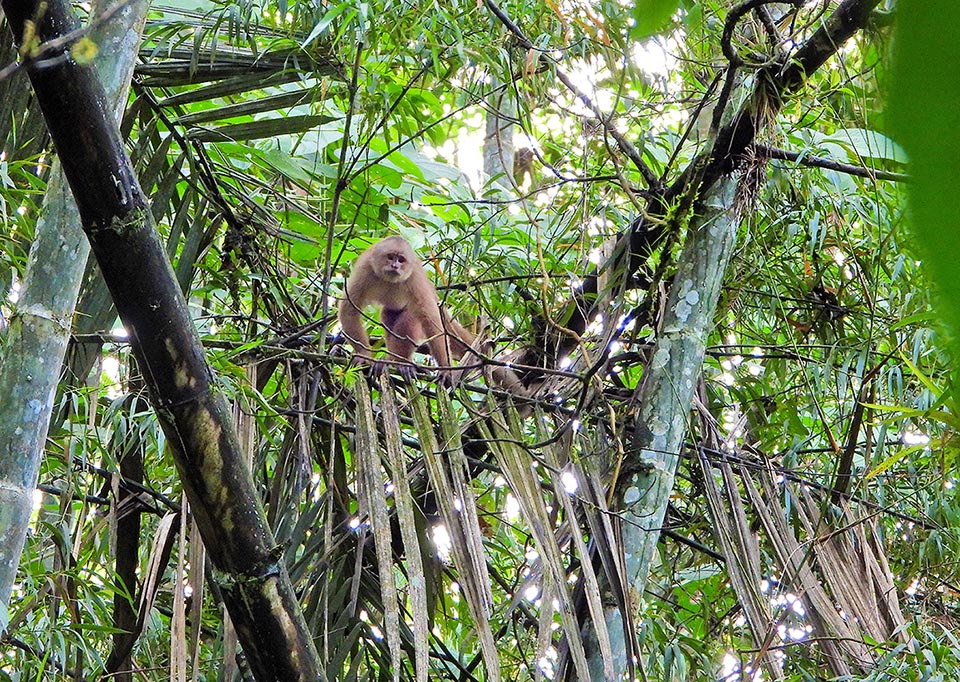
Ecuadorian white-fronted capuchin (Cebus aequatorialis) lives in west Ecuador and north-western Peru forests © Ilario Bailot
The Ecuadorian white-fronted capuchin or Ecuadorian capuchin (Cebus aequatorialis J. A. Allen, 1914), is one of the 25 species of primates at a higher risk of disappearance on the planet so much to be placed in the Red List of the International Union for Conservation of Nature (IUCN 2015) in the category “CR, Critically Endangered“, that is in extreme danger of extinction in the natural environments, the level anticipating the complete extinction in nature.
To understand the causes that have led this species into the abyss is fundamental because in a few decades they have caused a reduction of at least the 80% of the native population of Cebus aequatorialis. The Ecuadorian white-fronted capuchin is first and foremost an endemism of the western plains of Ecuador and of the north-west of Peru, therefore a species that already in nature has a relatively limited range and, on top of that, in locations subject to a heavy activity of deforestation that has led to a reduction of the 99% of the territory originally occupied by these animals.
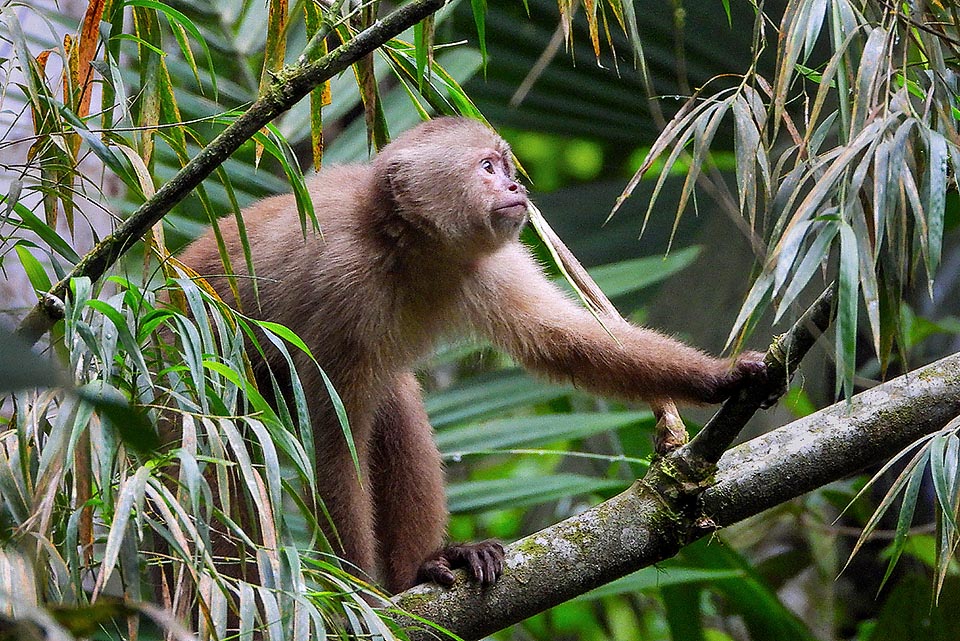
Active during the day it moves skilled among the branches in 5-20 units groups led by an alpha male © Ilario Bailot
The radical transformation of the territory has caused the loss of primary habitats resulting in fragmentation and consequent isolation of the populations, moreover constantly threatened, by the poaching for the meat, the poisoning activities of the local farmers, because considered as harmful species, besides by pathogen outbreaks foreign to the areas where they do live and finally by the illegal capture as animal to be kept in captivity.
The genus Cebus, from the Greek “kêbos” that is monkey, transliteration of a word used by Aristotle to identify some African monkeys with long tails and resumed only in 1777, in the midst of Enlightenment, by Johann C.P. Erxleben, professor of zoology at the Georg August University of Göttingen, to identify some Neotropical primates Cebus and Sapayus, are the two genera forming the family Cebidae whilst the subfamily Cebinae, includes exclusively all the species of the genus Cebus, known generically as “Without tuft capuchins” or “gracile”, widely distributed in all Central and South America and characterized by a slender body and limbs longer than their cousins of the genus Sapayus.
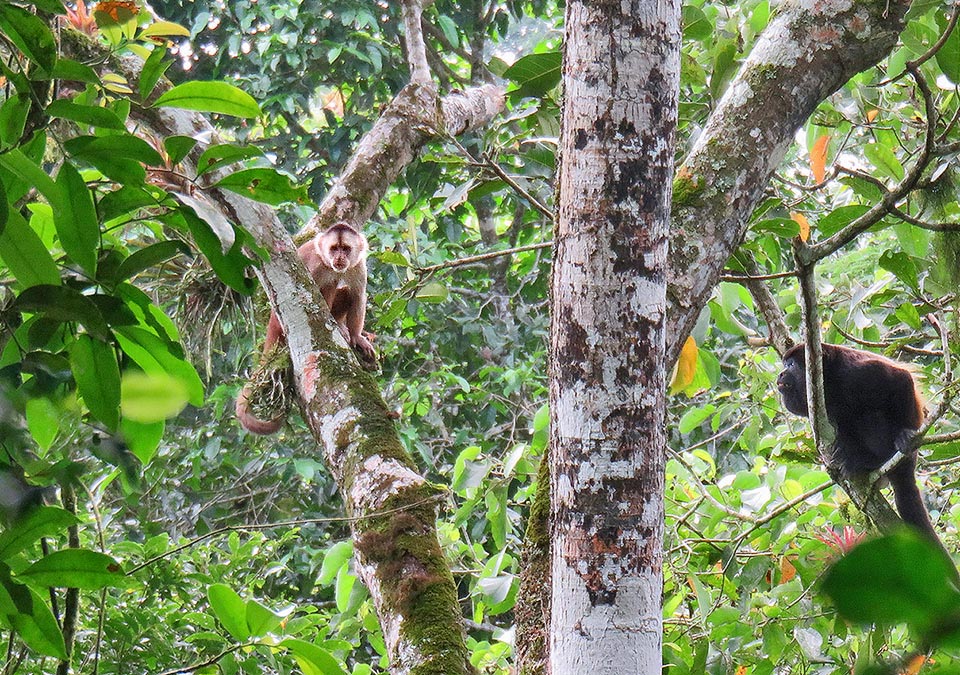
Sometimes it shares its range with other species of Cebus or with howler monkeys like this Alouatta palliata © Juliana Salcedo
Cebus aequatorialis once considered as a subspecies of the White-fronted capuchin (Cebus albifrons ssp. aequatorialis JA Allen 1914), has been raised to the rank of species after the work done by Katharine M. Jack and Fernando A. Campos in 2012, based on the concept of phylogenetic species supported by the genetic investigation work done by Jean P. Boubli and staff in 2012, by Manuel Ruiz-Garcia between 2010 and 2018, based on the geographic isolation by other populations of Cebus albifrons and the cranio-morphological ones by L. Albuja in 2018.
Zoogeography
The distribution area of the species, as the name suggests, concerns the woody areas of western Ecuador and of north-western Peru with an altitudinal gradient going from 0 to 2420 m above the sea level.
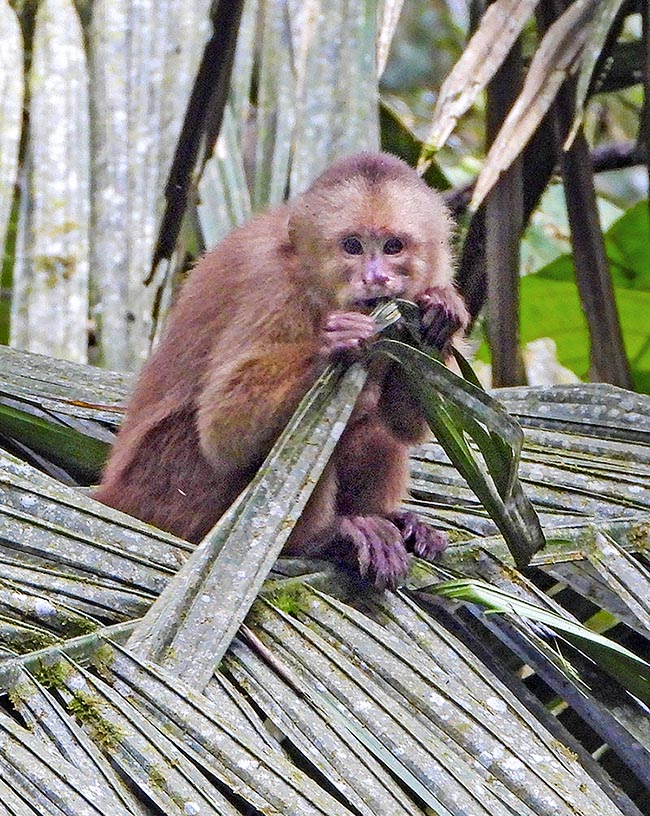
Cebus aequatorialis spends most of the day looking for food. This chews the leaves of Phytelephas macrocarpa, a rainforest palm locally known as Tagua, growing up to 1200 m of altitude usually along water streams © Ilario Bailot
Its northern limit, after the latest findings, appears to have moved little further north of the Guayllabamba-Esmeralda Rivers whilst the southern one seems to correspond with the Cerros de Amotape National Park in Peru.
The most known sites are located not far from the coast on the Pacific Ocean but some new sites have been identified at the feet of the Ecuadorian Andes in the province of Cotopaxi.
However, to a relatively vast territory, corresponds a habitat now hopelessly fragmented with poor possibilities of connection among the remaining small populations, and this represents one of the biggest threats to the sustainability of the species and thus rendering difficult the estimations done by the few census plans launched for this species in Ecuador, whilst for the Peru the information relating to the species are extremely scarce.
Habitat-Ecology
The Ecuadorian white-fronted capuchins live in the tropical and subtropical forests present in the ecoregions of Tumbes-Chocó west of the Andes.
Actually, it’s matter of an ample variety of environments: the dry Ecuadorian forests, the humid primary and secondary forests preferably close to the water streams, the undisturbed rainforest of Chocó, the premontane forest besides the mangroves forests, where it is seen as a direct competitor to the crabs hunting by the local populations, peculiarity also documented only in the periods of “lean food”. At times it is a stealthy visitor to orchards and plantations of cocoa, bananas and corn and for this reason is regularly persecuted by the local population, poisoned and hunted.
The study done by Kattharine M. Jack and Fernando A. Campos of 2013, proves how the natural environment for the species is essential suggesting how the environmental conditions for sustaining these capuchin monkeys include a tree cover greater than 25%, seasonality with mild temperature, annual rainfalls less than 2000 mm and low density of human population.
With its fairly ample diet, Cebus aequatorialis is considered a “generalist” species, because it ranges from ripe fruits, nuts and seeds to the leaves of various essences, particularly arboreal.
In some studies performed in the Ecuadorian forest of Cerro Blanco has been observed a food panel formed by leaves of various species of Bromeliaceae, fruits of Vitex gigantica, and belonging to the genera Spondias, Eugenia, Ficus and Cecropia.
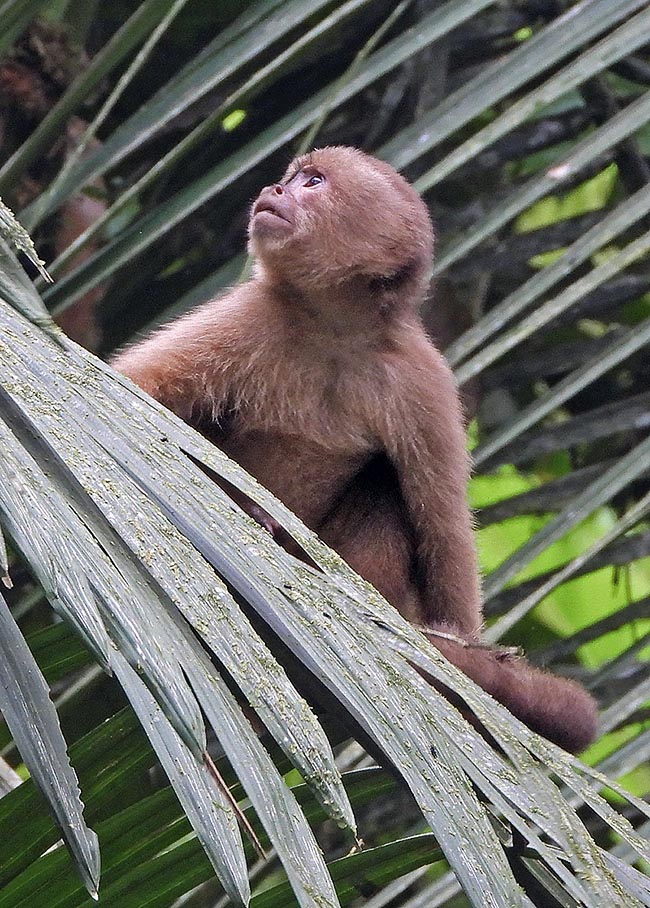
Then it sees that the group has found above, among the canopy branches, tasty fruits © Ilario Bailot
In Ecuador, after a recent study made by L. Albuja dated 2018, have been identified more than thirty species belonging to its diet, that is normally integrated with various arthropods including hymenopterans, eggs and small arboreal vertebrates.
The rôle of these primates, for the ecological systems where they live is in primis the involuntary dispersal of the seeds through the faeces, contributing substantially to the propagation and sprouting of new trees and consequently to the regeneration of the ecosystem.
Morphophysiology
Cebus aequatorialis is a medium sized primate that presents an almost perfect bilateral symmetry in its body.
The body is 35-50 cm long with the tail going from 39,5 cm to 50 cm, which renders their look rather slender, with tails that are even longer than their bodies. The long tail guarantees a greater stability, strength, control of the movement and like for the other South-Central America monkeys, is prehensile, that means that they can grab the branches, even supporting their weight while looking for food among the trees, just like it is a fifth limb. Usually the males are heavier than the females (3,4 kg compared to 2,9 kg). The mass is concentrated mainly on the limbs in a way to render easier the skillful movement among the trees looking for food.
For what longevity is concerned, we do not have presently sure data, but the genus Cebus in nature is quite long-lived reaching even 40 years whilst in captivity they may reach 45 years or more.
The fur that covers the body almost totally, is dense but not thick, presents a general colouration of the fore part of beige/pale khaki colour tending to darken in the areas closer to the belly than to the chest. The rear parts are pale brown of a wide variability from individual to individual and that tends to become of cinnamon colour with a darker line of hair running along the back. The face and the hands tend to be grey-brown whilst the feet are pale brown. In males, the tail may present with a very clear tip compared to the rest of the body.
Ethology-Reproductive Biology
This one, like other capuchin monkeys, is a species active during daylight hours, who dedicates a good part of the day looking for food, exploiting all the layers of the forest, from the canopy to the leaf litter, where it goes not only for recovering the fallen fruits, but also for looking for hidden invertebrates, rummaging and manipulating foliage and branches fallen from the top, with surprising skill, tenacity of action and even using tools, this thanks to their brain capacity.
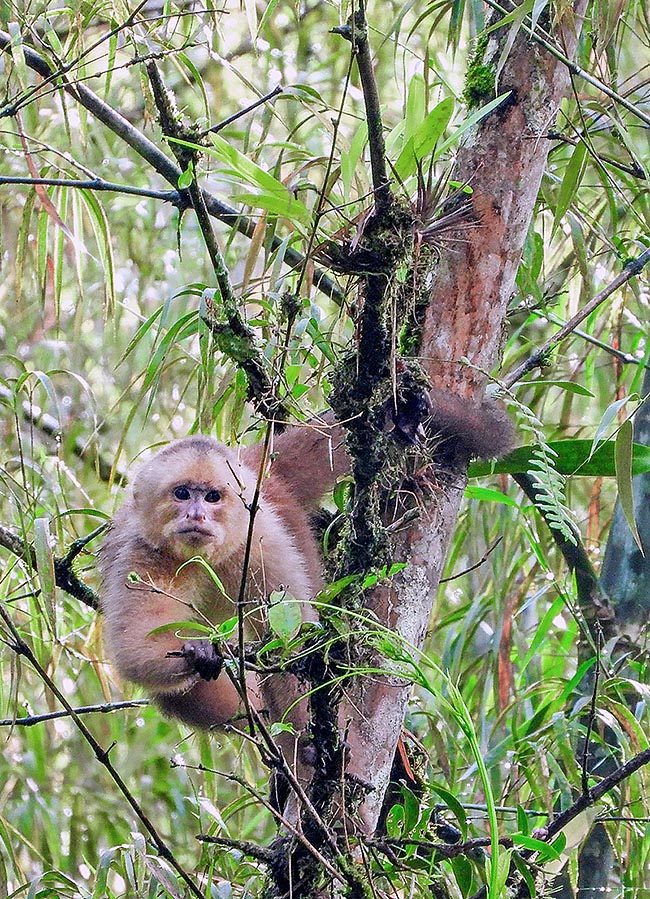
They are even 35-50 cm long monkeys with prehensile tail of the same size often used as a fifth arm © Ilario Bailot
The biometric analyses have proven how the encephalic mass presents clearly bigger compared to what we might expect from their body weight.
In addition to searching for food, the time is employed for strengthening the social ties, as this is a species living in groups, even if, rarely, solitary individuals have been noted.
The groups, made up of more females and more males, are formed by 5-20 members in order to guarantee safety and to satisfy the various social requirements to be so intense as to render solitary life difficult.
These monkeys can amso merge groups of other species such as the spider monkeys or the howler monkeys or in some cases unite with others of the genus Cebus, in the instances where an overlapping of the distribution areas occurs. It would seem from recent research that once the size of the groups was larger and that they have progressively reduced due to the scarcity of the available natural resources.
The group life is very active and besides the foraging activities, all spend a lot of their time to interaction between individuals through grooming (removing of lice), that helps to warm up the social relationships, albeit usually the alpha male and the alpha female regt the grooming, but they do not do it to the other members of the clan. Usually, the adult females tend to be slightly more numerous than the adult males, and the immature females compared to the mature ones keep averagely a high ratio with an average of approximately1,5.
It has been noted that most of the groups are formed by adult females with one alpha male leader and a number of usually younger males who do not display aggressive behaviours except when males belonging to different groups meet in the foraging territory.
In-depth studies from a communication point of view have not been carried out, however it seems that they follow the mechanisms of other species of Cebus, that is vocal calls, movements and body expressions, like using the limbs to indicate things or raise eyebrows to express an emotional state, show the teeth in sign of threat or shout at each other to express discomfort. Typical are the strong calls for reporting their position to the other members of the group, as well as weak and intermittent squeaks when they carry out an activity that gives them a state of well-being, like feeding, or a sort of purr during the grooming activity as well as a sort of curious “excited babbling”.
Also, as it can be seen in certain situations in the human species, they are able to jump and break branches when strongly excited, for instance when they have overwhelmed a rival group and are sure to stand in a safe zone.
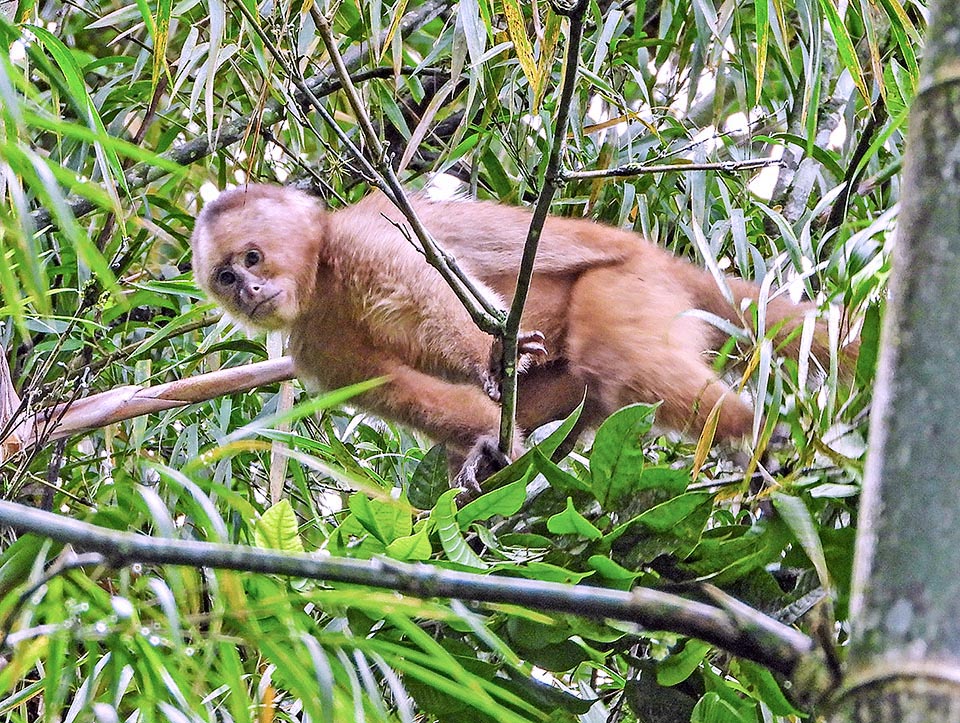
They keep in touch with vocal calls but also with gestures or raising the eyebrows, at times with a dissuasive look like in this case © Ilario Bailot
The Ecuadorian white-fronted capuchins are an elusive species not easy to meet and much less to be approached by man, this entails a great difficulty in carrying out a monitoring program.
For what the reproductive biology of the species is concerned, we don’t have much information. The females reach the sexual maturity between the 4 and 7 years of age whilst the males are of about one year a little later; however, achieving this stage does not guarantee a successful pregnancy; for this reason is considered to have reached the body size suitable to grant reproductive success around the 15 years.
From the observations made it seems probable that the adult alpha males tend to mate with more females through a presently unknown ritual but, even if we believe by observing similar species, that it happens through the pursuit of males by the females via dynamics that then trigger the interest in mating of the same. Once the period of pregnancy has passed, of which no sure information are available, only one cub comes to life and its weaning lasts several weeks.
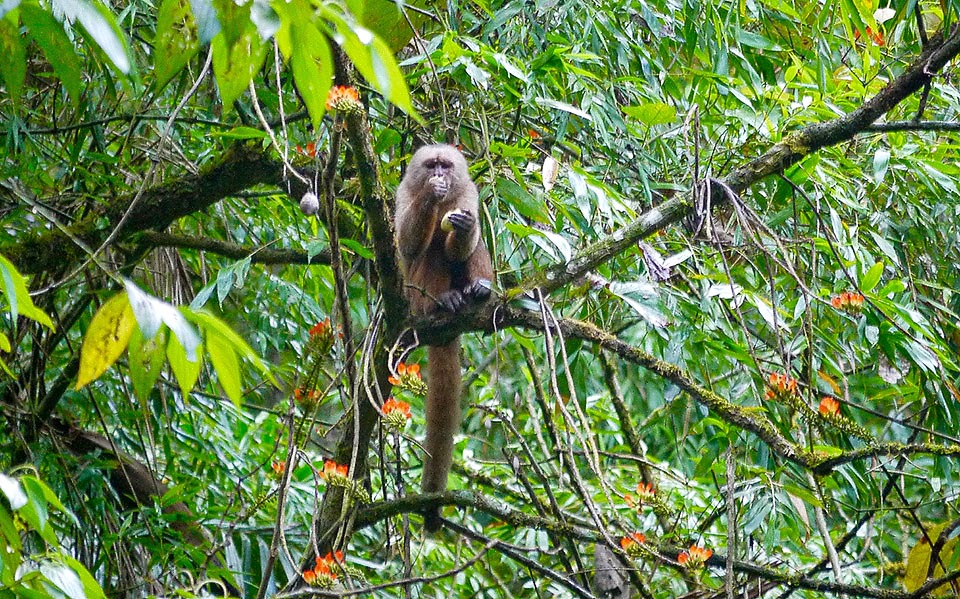
Here it eats fruits but it’s a species with a very varied diet. In fact when it recovers the fallen fruits rummages in the litter looking for hidden invertebrates © Olivia Crowe
This is a period where the puppy spends most of its time clinging to its mother, releasing the grip only occasionally for exploring the surrounding environment. The cub gets the maternal care for about one year, after which enters the juvenile phase where it will be cared for by the whole group in order to disengage the mother allowing her to get into oestrus again in the next mating season. Actually in the clans of these primates develops an “allomothering” behaviour, where males and females of the group collaborate together in the care of the little ones and the young less than two years old are cared for and breastfed by the alpha females of the clan.
Status of the populations, conservation and threats
Cebus aequatorialis is included in the Appendix II CITES and it is unlawful to hunt it or trade it in Ecuador as well as in Peru, however the poaching for food or commercial purposes and the poisoning because deemed harmful for the cultivated fields are real and difficult issues to tackle in those regions.
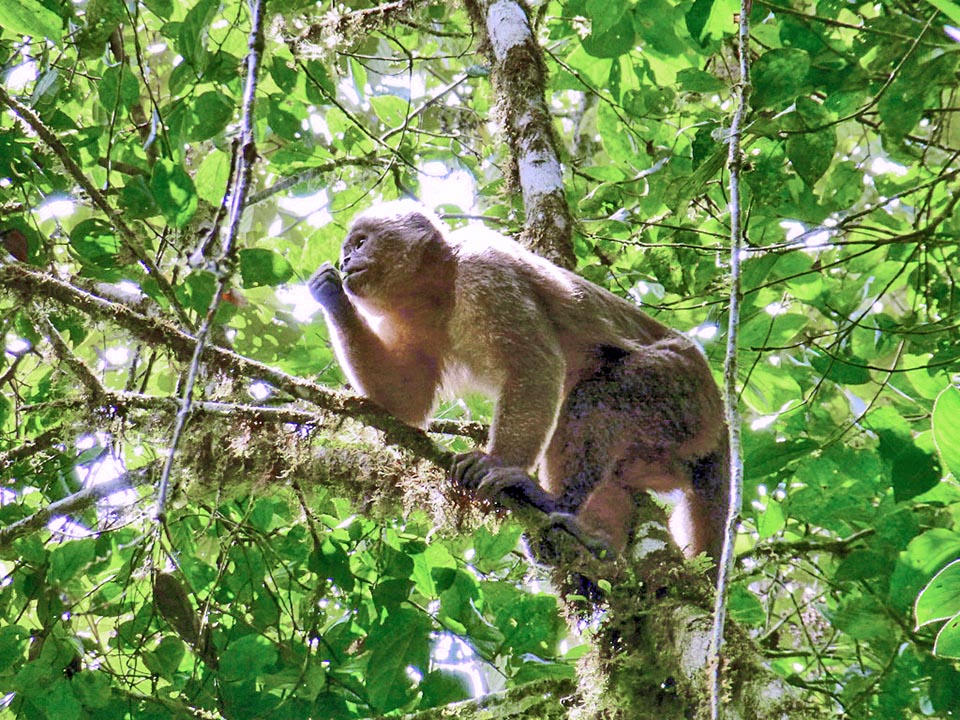
Leaves, flowers and buds are however, like for howler monkeys and generally the primates living on trees, the main dish of their diet © Olivia Crowe
The Ecuadorian territory from the midst of the 70s has been subject to the construction of penetration roads finalized to extracting-mining activities and to the obtainment of valuable wood leading in the 80s to a colonization of agricultural extensive nature projected towards monocultures and the crazing of cattle, leading the areas to an uncontrolled as well as wicked deforestation.
The loss of the forests due to the deforestation activities done in a systematic way in all western plains of Ecuador, from the Ocean coast up to the feet of Andes, has caused the irretrievable disappearance of the habitats more precious in biodiversity and of difficult reconstruction, like the primary forest or, in the best case scenario, their fragmentation as well as that of the populations of animals who lived there.
The few and reduced surviving populations, like in the case of the Cebus aequatorialis, are overwhelmed by the isolation and by the consequente little or even none genetic renewal in the last three generations (48 years) and what’s more the last portions of orest which remained intact, continue to be subjected to deforestation and degradation pressed by agricultural and mining activities.
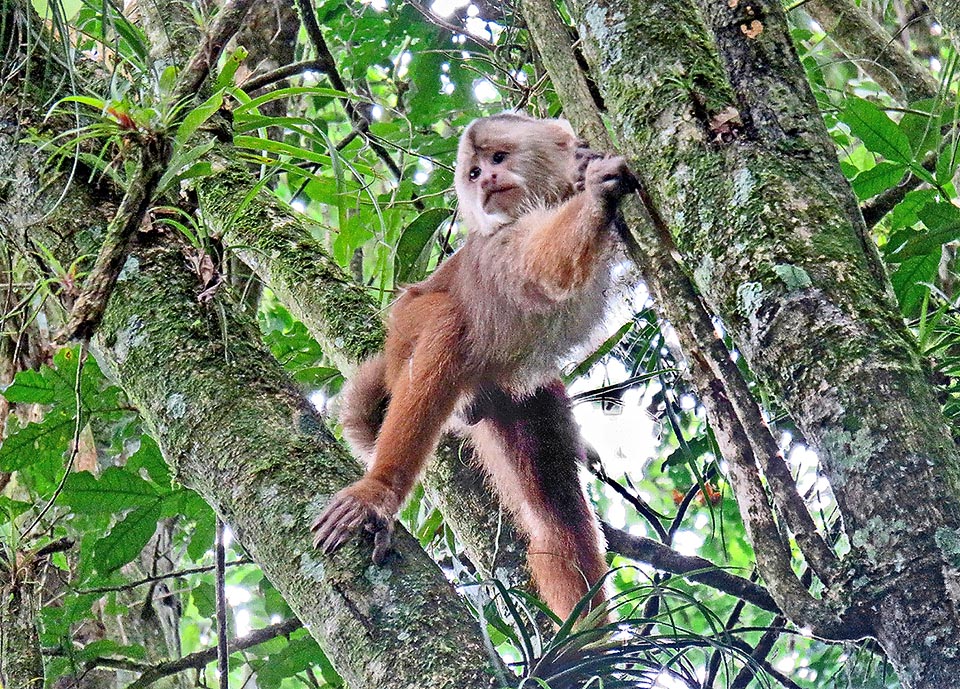
A young male. Cebus aequatorialis is a species at high risk of extinction due to the deforestation, the poaching for the meat or the illegal capture for the captivity life, the poisoning activities done by the local farmers who see their crops threatened, and especially the fragmentation of the populations on the territory © Juliana Salcedo
Some rare isolated groups remain in few protected areas but we have also to take into account that who is a limited total load capacity of the same areas, that, already little extensiven cannot contain more than a certain number of individuals.
Cebus aequatorialis is an emblematic case, where the priority is the remaining habitat protection and although most areas where stands the species are protected, is more necessary than ever a further safeguard and good management of the land and water resources in order to limit a further fragmentation due to human activities and the realization of infrastructures that destroy, separate and modify irremediably the environment.
The projects aimed to acquisition and protection of new natural or naturalizable area, through a process of reconstruction of the diversity and of the abundance of the wildlife, represent now a fundamental direction and especially in regions subjected to political instability, the private initiative becomes more than ever an added value in support of the already weak public institutions.
→ For general notions about Primates please click here.
→ To appreciate the biodiversity within the PRIMATES please click here.
